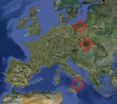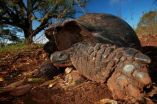(Press-News.org) Chromosome number is the most basic feature concerning the genome of a species, and it is known for about one third of higher plant species. In particular, for plants of Italy, Slovakia, and Poland, online chromosome number databases have been developed: 'Chrobase.it – Chromosome numbers for the Italian flora', 'Karyological database of ferns and flowering plants of Slovakia' and 'Chromosome number database – PLANTS', respectively. The three datasets account for about 35%, 60% and 40% of the whole floras, respectively.
"We used these datasets to compare chromosome number variation among plants of the three countries, with the aim to verify whether the patterns of chromosome number variation parallel the differences in latitudinal ranges" said Dr Peruzzi, leading author of the article, published in the open access journal Comparative Cytogenetics.
A concept that the occurrence of multiple genome copies (polyploidy) in plants tend to increase with latitude had already been formed in the second half of twentieth century, but pioneer works in this field had not significant statistical coverage, due to the absence of large, readily accessible datasets.
In the study, significant differences among the three countries were evidenced, confirming that mean chromosome number increases with increasing latitude. Mean chromosome number was used as an objective proxy of polyploidy.
In perspective, it would be interesting to verify whether the same chromosome number evolution dynamics occurs in the Austral hemisphere as well. Unfortunately, as far as we are aware, large chromosome number databases of these territories with significant latitudinal variations are not available, at the moment.
INFORMATION:
Original source
Peruzzi L, Góralski G, Joachimiak AJ, Bedini G (2012) Does actually mean chromosome number increase with latitude in vascular plants? An answer from the comparison of Italian, Slovak and Polish floras. Comparative Cytogenetics 66(4): 371–377. doi: 10.3897/CompCytogen.v6i4.3955
Posted by Pensoft Publishers.
From Mediterranean coasts to Tatra Mountains and beyond: Plant chromosome number variation
2012-11-27
ELSE PRESS RELEASES FROM THIS DATE:
Researchers explore social media as preventative method for infectious diseases
2012-11-27
MANHATTAN, Kan. -- When it comes to stopping illness, social media posts and tweets may be just what the doctor ordered.
A Kansas State University-led research team is looking at social media as a tool to reduce and prevent diseases from spreading. Researchers are studying whether a well-timed post from a public authority or trustworthy person could be as beneficial as flu shots, hand-washing or sneezing into an elbow.
"Infectious diseases are a serious problem and historically have been a major cause of death," said Faryad Sahneh, Kansas State University doctoral candidate ...
Man's best friend: Common canine virus may lead to new vaccines for deadly human diseases
2012-11-27
Athens, Ga. – Researchers at the University of Georgia have discovered that a virus commonly found in dogs may serve as the foundation for the next great breakthrough in human vaccine development.
Although harmless in humans, parainfluenza virus 5, or PIV5, is thought to contribute to upper respiratory infections in dogs, and it is a common target for canine vaccines designed to prevent kennel cough. In a paper published recently in PLOS ONE, researchers describe how this virus could be used in humans to protect against diseases that have eluded vaccine efforts for decades.
"We ...
Galapagos tortoises are a migrating species
2012-11-27
This press release is available in German.
The Galapagos giant tortoise, one of the most fascinating species of the Galapagos archipelago, treks slowly and untiringly across the volcanic slopes. Scientists of the Max Planck Institute for Ornithology in Radolfzell, together with the Charles Darwin Foundation, have used GPS technology and modern 3D acceleration measurements to find out that especially the dominant male tortoise wanders up to 10 kilometres into the highlands of the island. Only the fully grown animals migrate, the young tortoises stay year round in ...
Do missing Jupiters mean massive comet belts?
2012-11-27
Using ESA's Herschel space observatory, astronomers have discovered vast comet belts surrounding two nearby planetary systems known to host only Earth-to-Neptune-mass worlds. The comet reservoirs could have delivered life-giving oceans to the innermost planets.
In a previous Herschel study, scientists found that the dusty belt surrounding nearby star Fomalhaut must be maintained by collisions between comets.
In the new Herschel study, two more nearby planetary systems – GJ 581 and 61 Vir – have been found to host vast amounts of cometary debris.
Herschel detected ...
Researchers study cry acoustics to determine risk for autism
2012-11-27
Autism is a poorly understood family of related conditions. People with autism generally lack normal social interaction skills and engage in a variety of unusual and often characteristic behaviors, such as repetitive movements. While there is no specific medical treatment for autism, some success has been shown with early behavioral intervention.
Understanding the importance of early diagnosis, researchers at Women & Infants' Brown Center for the Study of Children at Risk in collaboration with researchers at University of Pittsburgh have been studying the cry acoustics ...
Flu outbreaks predicted with weather forecast techniques
2012-11-27
Contact: David Hosansky
hosansky@ucar.edu
303-497-8611
Zhenya Gallon
zhenya@ucar.edu
303-497-8607
National Center for Atmospheric Research/University Corporation for Atmospheric Research
Flu outbreaks predicted with weather forecast techniques
BOULDER – Scientists at Columbia University and the National Center for Atmospheric Research have adapted techniques used in modern weather prediction to generate local forecasts of seasonal influenza outbreaks. By predicting the timing and severity of the outbreaks, this system can eventually help health officials ...
Cell Transplantation reports islet cell advancement increases impact on transplantation
2012-11-27
Putnam Valley, NY. (Nov. 27, 2012) – A study published in the current issue of Cell Transplantation (21:8), now freely available on-line at http://www.ingentaconnect.com/content/cog/ct/ , reports that a team of researchers in South Korea have successfully engineered islet cell clusters (ICCs) that will improve pancreatic islet transplantation and offer promise for curing diabetes mellitus.
Carried out by collaborating researchers at three universities in Seoul, Korea, the new process of creating ICCs included delivering a gene to single islet cells that increased their ...
An energy conscious workforce: New research looks at how to encourage staff to go green
2012-11-27
As homeowners we are becoming cannier about turning down the thermostat to save our pennies and the planet but are we as energy conscious when we get to work?
A new £1.3m project, being led by researchers at The University of Nottingham, is to look at people's attitudes to energy consumption in the workplace and how to encourage colleagues to work together in reducing their organisation's carbon footprint.
Drawing on technical expertise at Nottingham's Horizon Digital Economy Research and design skills of experts at The University of Southampton, the five-year study ...
Study suggests different organ-derived stem cell injections improve heart function
2012-11-27
Putnam Valley, NY. (Nov. 27, 2012) – A study published in the current issue of Cell Transplantation (21:8), now freely available on-line at http://www.ingentaconnect.com/content/cog/ct/, has found that when mesenchymal cells derived from skeletal muscle (SM-MSCs) or adipose tissue (ADSCs) were injected into the heart muscle (myocardium) of separate groups of laboratory rats that had suffered a myocardial infarction, rats in both groups experienced significantly improved left ventricle function and smaller infarct size after cell therapy.
The study, carried out by researchers ...
Tracking pollution from outer space
2012-11-27
The thickest layers of global smog — caused by traffic, industry, and natural minerals, among other factors — are found over the world's megacities. But getting an accurate measurement of pollution is no easy task. On-the-ground monitoring stations do not always provide the most accurate picture —monitoring stations depend heavily on local positioning and some cities put stations in urban centers, while others build on the edge of a city.
Now Prof. Pinhas Alpert of Tel Aviv University's Department of Geophysics and Planetary Sciences and head of the Porter School of Environmental ...



